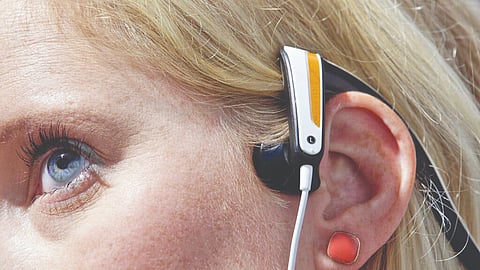

Veronique Greenwood
It is the rare person who likes hearing their own voice on a recording. It sounds fake, somehow — like it belongs to someone else. For neuroscientists, that quality of otherness is more than a curiosity. Many mysteries remain about the origins of hallucinations, but one hypothesis suggests that when people hear voices, they are hearing their own thoughts disguised as another person’s by a quirk of the brain. Scientists would like to understand what parts of the brain allow us to recognize ourselves speaking, but studying this using recordings of people’s own voices has proved tricky. When we talk, we not only hear our voice with our ears, but on some level we feel it as the sound vibrations travel through the bones of the skull.
A study published Wednesday in the journal Royal Society Open Science attempted a workaround. A team of researchers investigated whether people could more accurately recognize their voices if they wore bone-conduction headphones, which transmit sound via vibration. They found that sending a recording through the facial bones made it easier for people to tell their voices apart from those of strangers, suggesting that this technology provides a better way to study how we can tell when we are speaking. That is a potentially important step in understanding the origins of hallucinated voices.
Recordings of our voices tend to sound higher than we expect, said Pavo Orepic, a postdoctoral researcher at the Swiss Federal Institute of Technology who led the study. The vibration of the skull makes your voice sound deeper to yourself than to a listener. But even adjusting recordings so they sound lower doesn’t recreate the experience of hearing your own voice. As an alternative, the team tried using bone-conduction headphones, which are commercially available and often rest on a listener’s cheekbones just in front of the ear.
The team recorded volunteers saying the syllable “ah” and then blended each recording with other voices to produce sounds that were made up of 15 percent of a given person’s voice, then 30 percent, and so on. Then, they had some subjects listen to a series of the sounds with bone-conduction headphones, while others used normal headphones and another group tried laptop computer speakers. The volunteers indicated whether they thought each sound resembled their own voice.
People with bone-conduction headphones were more likely to correctly identify their own voices, the team found. When the researchers tried the same experiment using the voices of subjects’ friends — pairs of friends were recruited specifically for the study — they found that the bone-conduction headphones made no difference in helping people identify familiar voices. It was only recognizing their own voices that became easier, suggesting that the devices are recreating some of what we feel and hear as we speak.
That opens a door to understanding how one’s brain takes this sensory information and turns it into a recognition of one’s self. In a study published last year, the group recorded the neural activity of people performing these listening tasks and reported the existence of a network of brain regions that are activated as people work to identify themselves.
If scientists can understand how the brain builds the concept of self from sound, Dr. Orepic suggests, then perhaps they can unpack what is different in people who hear voices in their heads that are not their own. Perhaps someday listening to recordings of voices, including one’s own, with bone conduction devices could help doctors make diagnoses, if the tool’s performance could be linked to psychiatric disorders.
Visit news.dtnext.in to explore our interactive epaper!
Download the DT Next app for more exciting features!
Click here for iOS
Click here for Android